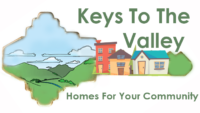Keys to the Valley has prepared a “toolbox” of strategies and policies that can be used to promote safe and affordable homes while strengthening our communities. These tools can be used by a variety of community partners – from municipal staff and board members to developers and providers of homes to non-profit support services.
The toolbox is organized according to the six major goals of the Keys to the Valley initiative. Each goal contains the following information:
- the action area (e.g., B: Ensure access to safe housing);
- broad objectives that relate to the goal (B3: Improve oversight and support for safe homes);
- more targeted strategies for achieving the objective (B3.2: Improve rental inspection);
- and specific tools for implementing the strategies (B3.2a: Update codes and inspection protocols)
A flowchart is provided for each goal showing the relevant objectives, strategies, and tools. Additionally, detailed descriptions are provided in the toolbox for those who want to take a deeper dive on a particular topic. Each tool also comes with a corresponding visual. You can learn how to interpret these visuals below.
Looking for the tools that are most relevant to you? Check out the following summaries for different interested groups:
- Financiers
- Municipal Officials, Staff, & Volunteers
- Residential Contractors and Developer
- Residents
- State Legislators
- Social Services Providers
Looking to dive right into an action area and explore on your own. Check out the following summaries for each of the six action areas:
Key Action Area A – Spread knowledge of the region’s housing needs
To increase public awareness of the region’s housing needs and opportunities, and to build acceptance of efforts to address these needs. This involves community outreach and coordination, sharing information and relatable stories, and developing metrics for monitoring the region’s housing needs.
Key Action Area B – Ensure access to a safe home
To ensure the availability of safe and sanitary housing for all residents, and their ability to get housing that is needed. This includes providing adequate emergency housing facilities; making sure that rental units meet all applicable codes for safe and sanitary habitation; reducing exposure to mold and lead hazards, and improving the knowledge of and compliance with legal requirements, such as the Fair Housing Law. Housing conditions are known to have a significant impact on physical and mental health.
Key Action Area C – Sustain Existing Primary Homes
To sustain existing homes in good condition and for use by year-round residents. This includes maintaining or improving the conditions of existing homes; keeping existing owner-occupied and renter-occupied homes as primary residences; and discouraging conversion to secondary homes or short-term rentals.
Key Action Area D – Make it easier to build homes
To make the process easier to build the types of homes that the region needs in the places we need them. This involves eliminating unnecessary regulatory barriers, streamlining the local and state review processes, and building grassroots support for proactively addressing our housing needs.
Key Action Area E – Create the types of homes the region needs
To create the types of homes that are necessary to address the region’s identified needs. This means building homes for our population and the range of income levels we have, prioritizing the creation of so-called “Missing Middle” and supportive housing types. This also involves building the capacity of local developers, building trades, and supportive housing providers.
Key Action Area F – Build smart for economic health
To build homes that improve the region’s economic health and are consistent with smart growth principles. This includes prioritizing housing developments that further village revitalization efforts, are served by water and sewer infrastructure, encourage walking, bicycling and public transit, and contribute to a stronger, more resilient community and stable tax base.

